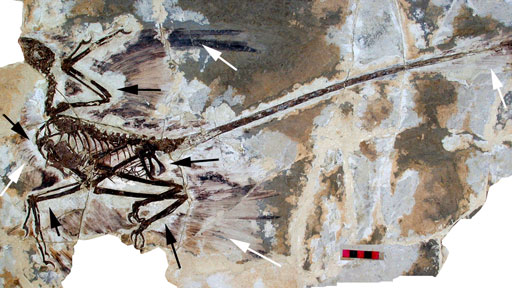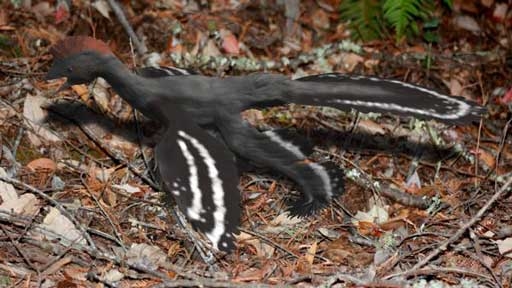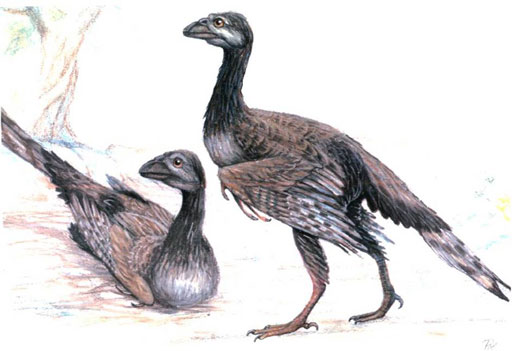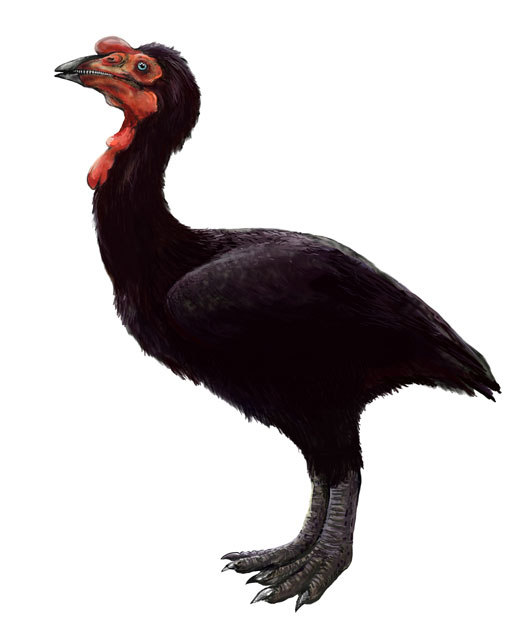
Every feathered thing — from the hummingbirds flitting near your feeder to the falcons that haunt lonely cliffs — has something in common, and it’s not just that they’ve got wings. Today’s modern birds descended from a single, surviving line of carnivorous, theropod dinosaurs that became small, delicate, covered in feathers, and were gifted with powered flight.
But how did this transition happen?
Since Archaeopteryx—easily the most famous early bird—was discovered in 1861, scientists have learned a great deal about the evolution of bird flight. The one prevailing theme in the development of modern bird characteristics from more “typical” theropod dinosaur features is that the path has by no means been direct or straight-forward.
Early bird evolution is full of weird offshoots and long-extinct prototypes as the lineage of dinosaurs that became modern birds experimented evolutionarily with flight.
First, there were feathers
When you look at today’s birds, it’s understandable to think of feathers and flight going hand in hand. But feathers themselves are far more ancient than flight in birds.
For decades, paleontologists considered this unique and complex modification of reptilian scales to be something that evolved only in the theropod dinosaurs closest to birds (like raptors). But we now know that feathers are as old as dinosaurs themselves, and probably appeared as fuzzy down on some of the earliest dinosaur species.

It now seems quite likely that most groups of dinosaurs, from long-necked sauropods to lumbering, horned ceratopsians like Triceratops, had some sort of feather or quill-like decoration on their bodies. These feathers and quills certainly wouldn’t have been helpful in getting all 110 tons of an Argentinosaurus off the ground, but this was also the case for the first feathered dinosaurs as well.
It doesn’t appear as though feathers first evolved specifically for flight, since for tens of millions of years, flightless dinosaurs were liberally adorned with the stuff. It’s possible feathers were first used as insulation (like fur in mammals), or as colorful displays, much like they’re used today. Many flightless species somewhat closely allied with the lineage that gave rise to birds appeared to use feathers in these ways, like Caudipteryx, a grouse-like omnivore from Cretaceous China, or Yutyrannus, a fuzzy early relative of T. rex.
The winding route to flight
Eventually, at some point during the mid-stride of the Mesozoic, some of these feathered dinosaurs started co-opting their feathers to generate lift and help them take to the air.
This was accomplished with the development of long flight feathers on the arms, which helped form the shape of an airfoil, similar to the wing of a plane. Once the shape of the wing—aided by the position of specialized, asymmetrical feathers—in cross-section had a curved front, a flat bottom, and an arching top surface, the birds could achieve lift when moving through the air.
This is because this airfoil shape allows air to move faster over the top of the wing than under it, reducing pressure on the top surface, causing pressure from below to push the wing (and accompanying bird) upwards. This is known as “Bernoulli’s principle of flight” and it was a central development to getting feathered dinosaurs off the ground in the first place. But exactly how and why the first birds used Bernoulli’s principle to get airborne is a matter of ongoing debate.
There are two primary theories on how this may have happened. One idea is that the very first fliers started off as gliders, incrementally using feather-laden arms to ease descent into neighboring trees, or onto ground-based prey. In this “tree-to-ground” scenario, tree-living proto-birds would have transitioned to flapping to stay aloft for even longer.
The second approach to flight evolution is the “ground up” option, or “wing-assisted incline running”, where early birds flapped their arms to help stabilize their running ascent into trees while fleeing from predators. This would help explain why flight got its start in animals so small and fragile compared to their predatory close-cousins; scampering up trees in terror is an experience relegated to small species low in the food chain.
Scientists aren’t sure exactly how the ancestors of modern birds first figured this out, since the fossil record is incomplete, and these behaviors are difficult to deduce anyways from physical remains, but the reality is that flight probably evolved from both directions, in different lineages multiple times. The result is that over tens of millions of years, there were scores of awkward, feathered creatures—many only distantly related to one another—all converging on powered flight from different evolutionary starting points.

The first creatures that flew
Some of the dinosaurs with the most rudimentary flying skills include the likes of Archaeopteryx and Anchiornis, a crow-sized animal with an abundance of feathers on the legs. While these species had long, broad flight feathers on the wings, they probably were only intermittent fliers at best for a number of reasons. Neither of these early birds appears to have a carina, a bony keel that juts out from the rib cage and allows the attachment of massive chest muscles for powering the downstroke in flapping. This means they wouldn’t be able to generate as much force on takeoff as modern birds. They also lacked key adaptations to their flight feathers found in later birds that make maintaining a stable airfoil possible. Taken together, it means that if Archaeopteryx or Anchiornis flew, it was in short bursts close to the ground, like a modern-day quail or pheasant.
Some families of early birds pioneered flight and wing features that would come to be mainstays in modern birds. One of these was Sapeornis, a hawk-sized dinosaur from about 120 million years ago that’s likely the earliest known soaring bird. It also may have had an alula, which is the small “winglet” formed by the thumb digit in modern birds that helps with fine-scale maneuvering at slow flying speeds or while landing.

An entire group of flying dinosaurs called enantiornitheans became strong fliers by adopting many new flight adaptations, seemingly independently of the family line that resulted in modern birds. Their name means “opposite bird”, referring to a configuration of their shoulder joint that’s entirely opposed to what modern birds are working with. These dinosaurs retained their jaws full of small teeth, and claws on their wings, but they were thought to be competent fliers, possessing shoulder flexibility, alulas, and wing and hand proportions more in line with modern birds than their ancestors. Opposite birds went extinct at the end of the Cretaceous, but at their end had branched out into a huge range of body shapes and lifestyles.
Some of modern birds’ closest relatives came into their own in the Cretaceous period, perfecting some key flight advancements. Fish-eating Yanornis, for example, was an early adopter of the ability to raise the wings far above its back, allowing for an efficient upstroke. But “primitive” features still hung around here and there. The aquatic bird Gansus still had claws on its wings. Ichthyornis had a partial beak lined with teeth. But these animals flew in a manner almost indistinguishable from modern birds, having gone through an evolutionary hacking away of superfluous weight by reducing things like tails and fusing bones over millions of years.
By the end of the Cretaceous, some birds—like chicken-sized Patagopteryx—had even pulled a quintessential modern bird trick by turning back the clock, becoming the earliest flightless birds.

But the road to the sky was filled with lots of dead ends and bizarre experiments. For example, take Microraptor, a four-winged miniature dragon that probably glided between trees rather than flew. There was also Yi qi, a dinosaur tangentially related to birds that had both feathers and bat-like wings, unlike anything known in the fossil record, apparently trying out flight completely independently from its cousins.
Only one lucky experimental lineage made it out of the Age of Dinosaurs alive, so the next time you see some of these survivors quacking and splashing down onto the pond at the local park, take a moment to appreciate the tangled, muddled, ever-pruning evolutionary process that generated the dazzling array of bird diversity we see today.




